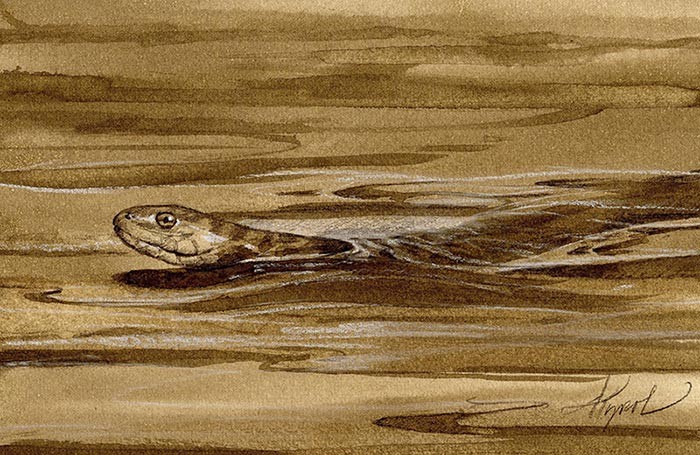
The northern watersnake, Nerodia sipedon, has a lot going against it in the eyes of most people. I’ve watched this medium- to large-sized snake clear a crowded lakeside beach in a matter of moments. As the local naturalist in my small town, I’ve become this snake’s self-appointed public defender. I’ve stopped children chasing it with large sticks, parents with rocks ready to throw, and once, a policeman who came ready to shoot.
“But it is poisonous, right?” he supposed.
No, the northern watersnake is not poisonous. It does resemble a poisonous snake: the cottonmouth, Agkistrodon piscivorus, also known as the water moccasin. Both snakes are found swimming and living along the water, and both are typically dark with dark-colored bands. If you want to see a cottonmouth, however, you would have to travel to Virginia to find one. New England does not have any poisonous water snakes.
I told the policeman this. His response, which I hear often, was, “Well, it is mean. It will bite you, right?”
The northern watersnake does respond aggressively when confronted. It gives its provocateur ample warning that it is agitated. Flattening its body and jaws, it will release a noxious musk to ward off offenders. It’s been known to regurgitate its previous meal in a last-ditch effort to prove how unappetizing it is. This isn’t really being “mean;” rather, it’s trying desperately to convince its attacker that it is not worth the trouble. I’ve shared a swimming hole with this snake for years. The only time I’ve ever seen the northern watersnake bite was when someone picked one up.
I told all this and more to the policeman. Like how these stout snakes slide both on top of and under the water. Its serpentine movement starts with the neck muscles contracting. The body then thrusts side to side, creating a series of curves. In water, this type of rippling movement propels the snake forward. As each contraction pushes against the water, a wave is created that pushes the snake onward.
The northern watersnake doesn’t have a streamlined tail or a laterally compressed body like some completely aquatic sea snakes. Because this watersnake is semi-aquatic, it must be agile on land and in water. Recently, researchers Abigail Pattishall and David Cundall of Lehigh University discovered that this snake has a fascinating adaptation that helps explain its supple swimming skills. By studying slowed-down videos of watersnakes swimming, along with detailed measurements and wax casts of the snakes’ bodies, the researchers determined that the northern watersnake changes its body shape while swimming. It laterally compresses its trunk, giving it a more streamlined shape with reduced drag for faster swimming.
Watersnakes measure 24 to 55 inches in length, and sport brown or black blotches over a brown or gray under-color. Its belly has black or red-orange crescents. As the snake ages, it can appear almost black, its pattern obscuring with age. While the snake basks on land, its keeled scales scatter and diffuse the light, giving it a dull, rough appearance. According to Dr. Barry Wicklow, an aquatic ecologist and professor at Saint Anselm College who has spent many years observing and studying northern watersnake, their dull, dry appearance gives the snakes camouflage as they bask on sunny rocks, landings, and the edges of old beaver dams. If the snakes glittered in the sunlight, they’d be an easy target for predators – particularly hawks.
Once, while snorkeling in the shallows, I came across a young northern watersnake. It was completely submerged amid a tangle of reeds. Under the water, in a shaft of sunlight, its tan and chestnut-brown body glistened. Perhaps it had just molted; its young skin shined like a treasure to me, vibrant among the green reeds. Wishing I could follow, I watched as it disappeared into the snarl of stems.
This year, I noticed that when the northern watersnake reeled across the top of the water into the swimming area at the local pond, people didn’t. Instead, they followed it with their eyes and marveled at how quickly it swam. The policeman wasn’t called, and when he did wander down to the beach, he told me about how many watersnakes he’d seen already this year.
I think it pays to know your neighbors. And as Dr. Wicklow likes to remind me, “The more you know about nature, the more interesting it becomes, and instead of fear, you have a sense of wonder and mystery.” That’s a good day at the beach, in my book.


Discussion *